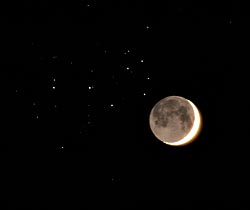
The crescent Moon sneaks up on the Pleiades in this view by Finnish astrophotographer Pekka Parviainen.
Late on Monday evening, October 9, 2006, observers with small telescopes throughout North America can see the bright gibbous Moon pass directly in front of the Pleiades star cluster. One by one, the cluster’s stars will wink out at the Moon’s bright (left) edge. Then, up to an hour later, each star will pop back into view along the dark (right) limb.
Remember that the Moon moves leisurely, taking a whole hour to shift by its own diameter against background stars. The Pleiades are never entirely hidden because the Moon has a smaller angular size than the cluster. Most of the action happens between 9 p.m. and midnight PDT for skywatchers along the West Coast, and from midnight to 2 a.m. EDT for those on the Eastern Seaboard.
For example, San Franciscans can watch the Moon heading directly for the cluster’s bright central star, Alcyone, causing it to disappear at 9:43 p.m. PDT and emerge at 10:37 p.m. For Dallas the occultation of Alcyone lasts a much shorter time, from 11:50 p.m. CDT to 12:22 a.m., and takes place near the Moon’s southern edge. For those watching from the East Coast the Moon misses Alcyone, instead cutting a swath through the bright stars at the cluster’s western (right) end around midnight.
If you wish, you can predict the times when several dozen stars will disappear and reappear at your own location; refer to the Pleiades chart and Moon tracks for 11 US major cities found on page 63 of the October 2006 Sky & Telescope. Experienced observers often join expeditions to a “graze line,” where the Moon’s north or south edge just touches a star, perhaps causing it to wink off and on several times as lunar mountains glide by. Further details of this event, and the scientific uses of occultations in general, have been posted by David W. Dunham and Rob Robinson of the International Occultation Timing Association.
Or, you can simply relax at home with your backyard telescope, track the Moon for a few hours, and enjoy the surprises every few minutes!
 0
0
Comments
You must be logged in to post a comment.